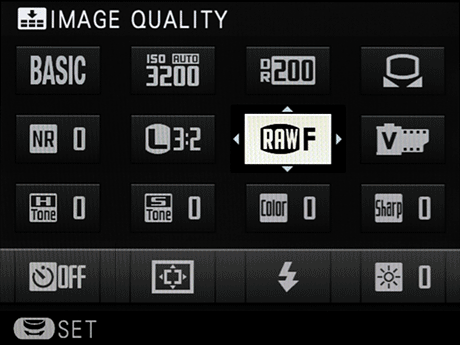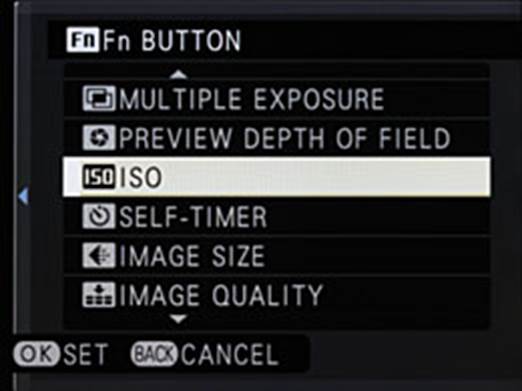Quick
Menu
Pressing the "Q" button at the
back of the Fujifilm X-E1 offers a Quick Menu, where you are able to change 16
options including ISO, DR, Film Simulation and timer. This is not entirely a
breaking-through concept, but the implementation of Fujifilm gets good scores
for clarity of layout and simple operation. You simply shift around the panel
using the four-way controller, then rotating the back dial button to change the
selected setting. The entire set of functions is available is listed in the
following table:

Q
Menu options
Q
Menu options (in the picture, from left to right respectively)
·
Select Custom Setting
·
ISO
·
Dynamic Range
·
White Balance
·
Noise Reduction
·
Image Size
·
Image Quality
·
Film Simulation
·
Highlight Tone
·
Shadow Tone
·
Color
·
Sharpness
·
Self-Timer
·
AF Mode
·
Flash Mode
·
LCD Brightness
The various
settings are interdependent, which might cause you to be initially confused
until you know what is happening. For instance, you cannot choose expanded DR
settings at ISO 200, or use extended ISOs when capturing RAW, and have to
change the conflicting setting first. Then, of course, you have to remember to
change it back again later; for example, it's all too easy to forget to
re-activate RAW after using the expanded ISOs.
In the movie mode, the Q menu drops down
significantly to four options; Movie Mode (i.e. Full HD or HD), white balance,
film simulation, and LCD brightness.
Customizing
Fn button

A
big button labeled "Fn"

Switching
back and forth between replaced settings
The Fujifilm X-E1 has a big button labeled
"Fn" beside the shutter that you can set the functions you use most
often (we tend to usually use it for ISO - see comments above). It works
exactly based on the selected function, or directly switches back and forth
between replaced settings, or puts up sub-menu available options.
The function that is currently assigned to
can move quickly by pressing the Fn button down and holding it for a second,
which calls up the menu options shown above. This might be really useful, for
instance, to quickly access to preview the depth of image or multi-exposure
mode. The available options are listed in the list below
Fujifilm
X-E1 Fn button options
·
Multi exposure (Toggle): Turn on / off multi
exposure
·
Preview the image depth (Toggle): Set lens to
select aperture for previewing the image depth.
·
ISO * (Enable / Toggle): In OVF, highlights ISO
- change with the spinning button or L / R keys. In EVF / LCD, activates ISO
submenu, change with up / down keys.
·
Self -Timer *, image size * Image Quality *
Scope * Simulate film *, White Balance *, AF mode *user setting options
*(Submenu): These settings bring a submenu listing available options.
·
Movie (Toggle): Access / escape the movie mode -
Press the shutter button to start/ stop recording.
·
RAW (Toggle): Enable or disable RAW recording
for a shot.
* Also available
in the Q menu
Silent
mode
The X-E1 provides familiar "Silent
Mode" of Fujifilm, which is switched off and on by pressing the DISP
button long. It is really a confusion of the name, because it disables not only
electronic operational noises, but also the AF illuminator and peripheral
flashes. Yet obviously it is not possible to disable the sound of mechanical
shutter - but fortunately this sound is rather quiet and discreet.
You are able to independently switch off
all of the electronic noises using the 'Operation Vol.' option in the Setup
Menu (tab 2), which you'll be able to want to do any way as soon as it is taken
out of the box, the X-E1 gives a quiet beep at you every time you press the
button. You also are able to disable the AF illuminator in the Shooting Menu
(tab 4) and set the flash mode to 'suppressed' from the Q menu. (Or, of course,
simply switch off the flash unit)
Shutter
noise
An important consideration for the target
market of the X-E1 is operational noise, and especially the shutter, something
that is fascinating of this camera is that has no flapping mirror, in terms of
theory it can be a little quieter than an SLR. Many mirror less cameras,
however, have shutters that are noisy enough to provide a little advantage in
this aspect.
The X-E1 still uses a focal plane shutter.
Therefore, it is definitely larger than the lens shutter equipped with
X100/X100S, but it is quieter than most of the flapping-mirror less products at
the same time (except for the Olympus OM-D E-M5). The shutter sound is
relatively low-pitched, and therefore less disturbing. This means that you will
be likely to have ability to use the X-E1 in situations where an SLR will not
be welcome, although the X100 / S still is a better choice when the camera has
to be increasingly as quiet as possible.
Electronic
level: Shooting from the hip
Life is less interesting when viewed from
the proverbial 5.9 inch perspective, and a camera having a live vision with the
level of built-in screen really helps detect more than the different angles
without stretching your back. The level of the X-E1 is neither perfect nor does
it give any information about pitch- your upward or downward tilt - but keeping
a straight horizon line is half the battle when using the rear LCD to shoot
images. However, we found that the level is not always true, so we propose
another solution when having a straight horizon line is extremely important.

Not
giving you any information about pitch

We
propose another solution when having a straight horizon line
Bugs
We confronted a few bugs while using the
X-E2, but many fewer than what we experienced with earlier X-series cameras.
The Drive mode button on our sample camera occasionally stopped operating,
which was mended by rebooting fast 0 at other times of exposure would simply be
wrong, either under or extensive exposure in every image. In those cases,
removing and replacing the battery might solve the problem.
Not really a bug, but nonetheless it also
causes controversy – the exposure compensation dial on our X-E1 is so easy that
it can be accidentally rotated. Often, simply holding the camera accidentally,
or letting it bump against a bag or clothing was enough to move the dial out of
its '0 ' neutral location.
Halfway towards the review, after
confirming that accidental exposure compensation had made too many impacts on
shots; we used a bit of Scotch tape to stick the dial button and crushed that
“bug”. It is easy to remove when necessary and cheap to replace if it is worn
out. Fujifilm announced that the dial has been tightened up on the
publicly-announced X100S, which is only likely to be a good thing.